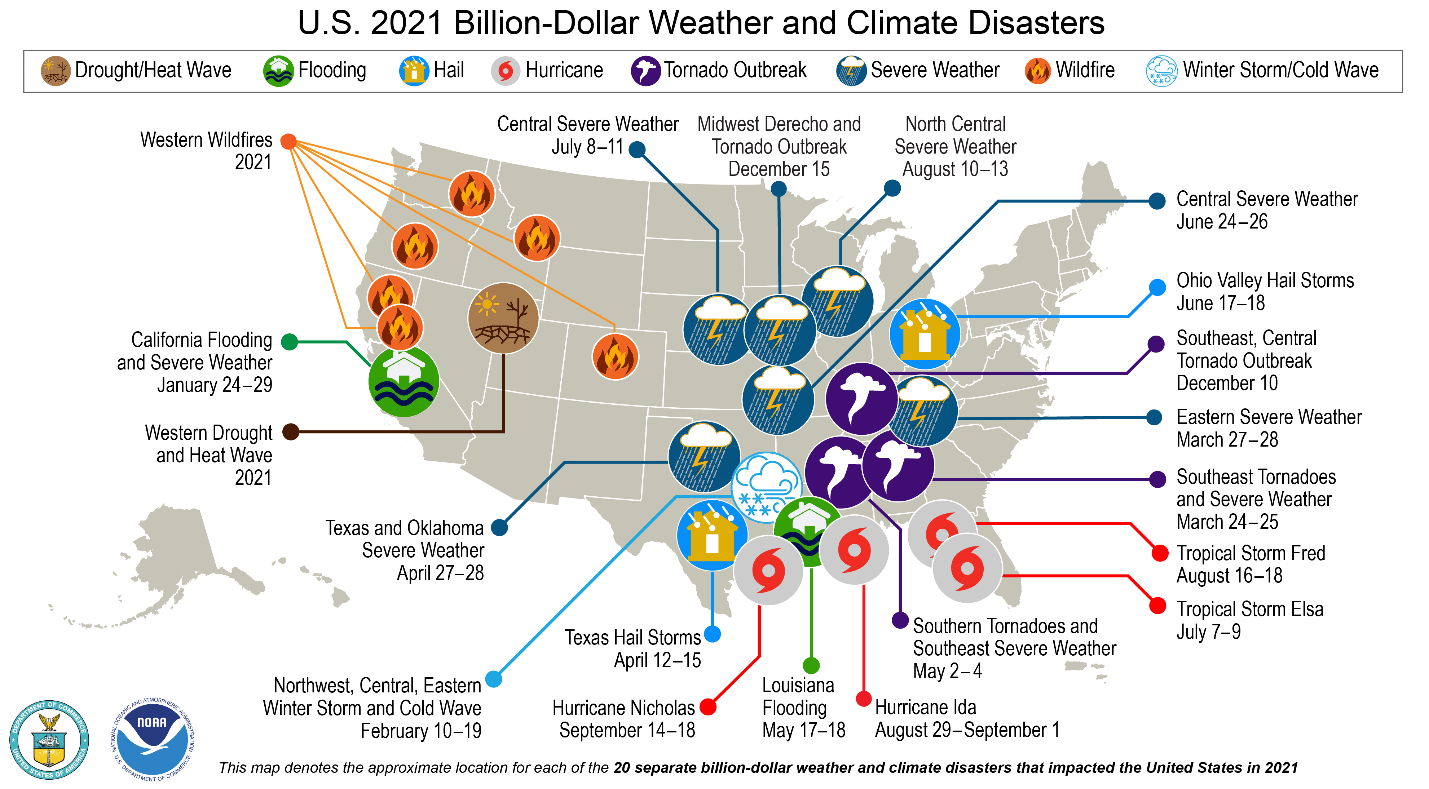Developing Resilient Communities is More Important Than Ever
This NOAA map showcases the $20 billion weather and climate disasters in the U.S. in 2021. (Map courtesy of NOAA and NCEI)
Building resilient communities has become an emerging priority throughout the United States—especially for those vulnerable to disastrous weather events. Through comprehensive planning that includes awareness and acceptance of risk, communities can better anticipate and plan for disasters, minimize damages and facilitate quicker recovery.
In 2021 alone, the National Oceanic and Atmospheric Administration (NOAA) recorded 20 weather and climate/disaster events with losses exceeding $1 billion each. The events included one drought, two floods, 11 severe storms, four tropical cyclones, one wildfire and one winter storm. The devastation resulted in 688 deaths and severe economic damages for those impacted communities.
Cities and counties today need to proactively design and implement plans that will reduce injuries and damage from severe weather events. To become more resilient, communities must adapt to changing conditions, allowing people and places to recover quickly from disasters and thrive in the face of adversity.
Managing Risks to Your Community
When communities enact resilient principles, they can assess and determine their risk before an event occurs. We’ve all heard of the 100-year flood, but if current rainfall trends continue, that may become more like the 10-year flood. A 2020 nationwide flood risk study suggests that flood maps may have left out as many as 6 million at-risk properties. For the 40 percent of Americans who live near the coast, rising sea levels may reach as much as a foot by 2050.
Community leaders need to account for these risks and examine how they can best prepare.
Key terms associated with resilience are:
Exposure—the location of assets and people in relation to hazards.
Vulnerability—a potential for loss of or harm due to the interactions of natural processes, land-use decisions and community risk factors.
Risk—the probability that a hazardous event and the resulting consequences will occur.
Adaptation—a community or region’s ability to grow stronger by changing its policies, processes and systems to reduce the impacts of sudden and slow-moving disasters.
Emerging Financial Opportunities
With the passage of the Infrastructure Investment and Jobs Act in November 2021, Congress targeted $46 billion in financial assistance to help communities become more resilient. But this isn’t all. Investment in roads, bridges, waterways and the electrical grid must meet more resilient standards as well. These funding opportunities are more abundant than ever and provide ample opportunities to revitalize aging and at-risk communities throughout the U.S.
Plan today to eliminate impacts of disasters tomorrow.
Designing with People, Planet, Place and Prosperity in Mind
By using mapping and modeling tools, communities can determine neighborhoods with a high level of exposure and vulnerability to floods, rising tides and cycles of drought or even long-term stresses like COVID-19.
Resilience principles can be designed based on a region’s distinct character and vulnerabilities to ensure they are carried through implementation.
By acting and building responsibly, communities can reduce overall system costs and minimize damage expenditures. These financial costs can be minimized by reducing future risk from baseline vulnerabilities defined at the onset of a project.
Halff’s creed is to put people first followed by the planet, place and prosperity. Multiple practices across Halff are involved in resilience projects including Water Resources, Planning and Landscape Architecture, Water/Wastewater, Public Works, Transportation, Environmental, Energy, Land and Site Development, Architecture and Construction Services.
Tools that can be used to create more resilient communities include:
-
- GIS analysis
- Watershed modeling and flood planning
- Equity and social vulnerability analysis
- Long-range and strategic planning
- Green infrastructure/low impact development
- Utility risk reduction and emergency preparedness
- Development of climate-ready ordinances and policy manuals
- Water utility risk and resilience assessments
- Vulnerability assessments
Halff can use its wide array of services to ensure your municipality minimizes impacts from severe storm events and bounces back from these events faster, with fewer fatalities and lower economic damages.
Related Articles:
-
- FEMA Opens Applications for $2.9 Billion to Build Resilience In Your Community
- Six Funding Opportunities to Increase Resilience in Your Community
- What Are the IIJA and IRA? Expert Tips on Planning for Project Funding
- Developing Resilient Communities is More Important Than Ever
- Funding Vision Zero Plans: How SS4A Grant Program Can Help Your Project in 2023
For more information about making your community resilient, reach out to Senior Resilience Planner Sean Lahav via email at sLahav@halff.com.




